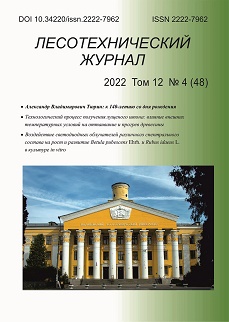Russian Federation
Russian Federation
Voronezh, Russian Federation
631.532/.535
581.14
58.085
Light-emitting diodes (LEDs) have shown high efficiency in growing plants both in vivo in greenhouses and in vitro, including clonal micropropagation. The purpose of this study was to analyze the effect of the spectral composition of LED irradiators with different proportions of red (RL) and blue (BL) light on the morphogenesis of microplants of the remontant form of common raspberry (Rubus idaeus L.) cv. Hercules and the selection valuable cultivar of downy birch (Betula pubescens Ehrh.), which is the object of a unified genetic breeding complex (UGBC), previously selected on the basis of drought resistance. In the variant 1, the RL/BL ratio was 80/20%, in the variant 2 it was 70/30%, in the control it was 50/50%. The LED in variant 1 contributed to the greatest increase in morphometric and anatomical characteristics in raspberry microplants, increasing the height of shoots, the number of leaves, stomata density, the height of the leaf epidermis and mesophyll. At the same time, an increase in the proportion of RL/BL led to an increase in the leaf area, leaf surface, and stomatal density in birch microclones; however, the anatomical characteristics of the leaf indicate a decrease in the height of epidermal cells and the size of mesophyll cells. Thus, the LED of option 1 can be recommended for use in clonal micropropagation of raspberries in greenhouses, to optimize growth processes and obtain healthy, normally formed plants, while birch requires additional selection of optimal spectral illumination conditions.
Betula pubescens, Rubus idaeus, in vitro, light emitting diodes, light spectrum, micropropagation, leaf mesostructure, morphogenesis, mesophyll
1. Dutta Gupta S. Light emitting diodes for agriculture. Singapore Springer Nature Singapore Pte Ltd, Singapore. 2017: 334. DOI: https://doi.org/10.1007/978-981-10-5807-3.
2. Landi M., Zivcak M., Sytar O., Brestic M., Allakhverdiev S. I. Plasticity of photosynthetic processes and the accumulation of secondary metabolites in plants in response to monochromatic light environments: A review. Biochimica et Biophysica Acta (BBA)-Bioenergetics. 2020; 1861: 148131. DOI: https://doi.org/10.1016/j.bbabio.2019.148131. EDN: https://elibrary.ru/QJRUHH
3. Batista D. S., Felipe S. H. S., Silva T. D. (et al.). Light quality in plant tissue culture: does it matter? In Vitro Cellular & Developmental Biology-Plant. 2018; 54(3): 195-215. DOI: https://doi.org/10.1007/s11627-018-9902-5.
4. Voitsekhovskaja O. V. Phytochromes and other (photo) receptors of information in plants. Russ. J. Plant Physiol. 2019; 66(3): 351-364. DOI: https://doi.org/10.1134/s1021443719030154. EDN: https://elibrary.ru/CYZSXO
5. Zakurin A. O., Shchennikova A. V., Kamionskaya A. M. Artificial-Light Culture in Protected Ground Plant Growing: Photosynthesis, Photomorphogenesis, and Prospects of LED Application. Russ. J. Plant Physiol. 2020; 67: 413-424. DOI: https://doi.org/10.1134/s102144372003022x. EDN: https://elibrary.ru/ZMHITC
6. Kudelina T. N., Konstantinov A. V., Obuhovskaya L. V., Molchan O. V. Osobennosti formirovaniya fotosinteticheskogo apparata mikroklonov Populus tremula L. i Betula pendula Roth. pri LED-osveshchenii razlichnogo spektral'nogo sostava v processe adaptacii ex vitro. Izvestiya Nacional'noj akademii nauk Belarusi. Seriya biologicheskih nauk. 2019;64(4):456-466. (In Russ.). DOI: https://doi.org/10.29235/1029-8940-2019-64-4-456-466. EDN: https://elibrary.ru/OKASRB
7. Yudina L., Sukhova E., Mudrilov M. (et al.). Ratio of Intensities of Blue and Red Light at Cultivation Influences Photosynthetic Light Reactions, Respiration, Growth, and Reflectance Indices in Lettuce. Biology. 2022; 11(1): 60. DOI: https://doi.org/10.3390/biology11010060. EDN: https://elibrary.ru/JQRNWB
8. Xiaoying L., Mingjuan Y., Xiaodong X. (et al.) Effect of light on growth and chlorophyll development in kiwifruit ex vitro and in vitro. Scientia Horticulturae. 2022; 291: 110599. DOI: https://doi.org/10.1016/j.scienta.2021.110599. EDN: https://elibrary.ru/XNDXCT
9. Chung G. J., Lee J. H., Oh M. M. Growth and Acclimation of In Vitro-Propagated M9 Apple Rootstock Plantlets under Various Visible Light Spectrums. Agronomy. 2020; 10(7): 1017. DOI: https://doihttps://doi.org/10.3390/agronomy10071017.
10. Tao R., Bai S., Ni J., Yang Q., Zhao Y., Teng Y. The blue light signal transduction pathway is involved in Planta. 2018; 248(1): 37-48. DOI: https://doihttps://doi.org/10.1007/s00425-018-2877-y. EDN: https://elibrary.ru/PDLRAD
11. Dănăilă-Guidea S. M., Delian E. An overview on blue light benefits on plants physiological performances and on plant products qualities. Scientific Papers. Series B, Horticulture. 2020; LXIV(1): 643-652.
12. Brelsford C. C., Robson T. M. Blue light advances bud burst in branches of three deciduous tree species under short-day conditions. Trees. 2018; 32(4): 1157. DOI: https://doi.org/10.1007/s00468-018-1684-1. EDN: https://elibrary.ru/TGXJGR
13. Matthews J. S., Vialet-Chabrand S., Lawson T. Role of blue and red light in stomatal dynamic behaviour. Journal of Experimental Botany. 2020; 71(7): 2253-2269. DOI: https://doi.org/10.1093/jxb/erz563. EDN: https://elibrary.ru/VBKTLC
14. Rahmati Ishka M. A surprising feature of the blue light: Regulation of leaf hydraulic conductance via an autonomous phototropin-mediated blue light signaling pathway in bundle-sheath cells. The Plant Cell. 2022; 231: 2231-2246. DOI: https://doi.org/10.1111/nph.17538.
15. Ni J., Dong L., Jiang Z. (et al.). Salicylic acid-induced flavonoid accumulation in Ginkgo biloba leaves is dependent on red and far-red light. Industrial Crops and Products. 2018;118:102-110. DOI:
16. Novikov A. I. Sovershenstvovanie tekhnologii polucheniya vysokokachestvennogo lesosemennogo materiala (Improvement of technology for obtaining high-quality forest seed material). Dokt. dis. Voronezh. 2021. (In Russ.). EDN: https://elibrary.ru/JXTBSB
17. Fernandes P., Tedesco S., Vieira da Silva I., Santos C., Machado H., Lourenço Costa R. A new clonal propagation protocol develops quality root systems in chestnut. Forests. 2020; 11(8): 826. DOI: https://doi.org/10.3390/f11080826.
18. Henao-Ramírez A. M., Urrea-Trujillo A. I. Somatic Embryogenesis for Clonal Propagation and Associated Molecular Studies in Cacao (Theobroma cacao L.). In Agricultural, Forestry and Bioindustry Biotechnology and Biodiscovery / Chong, P., Newman, D., Steinmacher, D. (eds). Springer, Cham. 2020: 63-102. DOI: https://doi.org/10.1007/978-3-030-51358-0_5.
19. Zeps M., Kondratovičs T., Grigžde E., Jansons Ā., Zeltiņš P., Samsone I., Matisons R. Plantlet Anatomy of Silver Birch (Betula pendula Roth.) and Hybrid Aspen (Populus tremuloides Michx.× Populus tremula L.) Shows Intraspecific Reactions to Illumination In Vitro. Plants. 2022;11(8):1097 DOI: DOI: https://doi.org/10.3390/plants11081097; EDN: https://elibrary.ru/MZIZCF
20. Gailis A., Samsone I., Šēnhofa S., Girgžde E., Kāpostiņš R., Jansons Ā. Silver birch (Betula pendula Roth.) culture initiation in vitro and genotype determined differences in micropropagation. New Forests. 2021; 52(5): 791-806. DOI: https://doi.org/10.1007/s11056-020-09828-9. EDN: https://elibrary.ru/BWQZHP
21. Kabylbekova B., Turdiev T., Chukanova N., Kovalchuk I. Optimization of in vitro cloning of different genotypes of fruit and berry crops. Journal of Biotechnology. 2019; 305: S59. DOI:https://doi.org/10.1016/j.jbiotec.2019.05.208.
22. Khlebova L. P., Titova A. M., Pirogova A. V. Biotechnological approaches to the reproduction of remontant forms of red raspberry. Ukrainian Journal of Ecology. 2019; 9(3): 402-405. URL:
23. Oseni O. M., Pande V., Nailwal T. K. A review on plant tissue culture, a technique for propagation and conservation of endangered plant species. International journal of current microbiology and applied sciences. 2018; 7(7): 3778-3786.
24. Aneli N. A. Atlas epidermy lista. Tbilisi: Mecnierba. 1975: 105 p. (In Russ.).
25. Su J., Liu B., Liao J., Yang, Z., Lin C., Oka Y. Coordination of cryptochrome and phytochrome signals in the regulation of plant light responses. Agron. J. 2017; 7(1): 1-22. DOI: https://doi.org/10.3390/agronomy7010025.
26. Nacheva L., Dimitrova N., Koleva-Valkova L., Tarakanov I., Vassilev A. Effect of LED lifgtning on the growth of raspberry (Rubus idaeus L.) plants in vitro. Agric. Sci. 2021; 13(29): 126-140. DOI: https://doi.org/10.22620/agrisci.2021.29.015.
27. Kudelina T. N., Krivobok A. S., Bibikova T. N., Molchan O. V. Features of Arabidopsis thaliana photomorphogenesis when using LED-lighting with different spectral composition. Proceedings of the National Academy of Sciences of Belarus, Biological Series. 2021; 66(1): 42-52. DOI: https://doi.org/10.29235/1029-8940-2021-66-1-42-52
28. Kudelina T. N., Krivobok A. S., Bibikova T. N., Molchan O. V. Features of Arabidopsis thaliana photomorphogenesis when using LED-lighting with different spectral composition. Proceedings of the National Academy of Sciences of Belarus, Biological Series. 2021; 66(1): 42-52. DOI: https://doi.org/10.29235/1029-8940-2021-66-1-42-52. EDN: https://elibrary.ru/ZMUZIU
29. Yakovceva M. N., Govorova G. F., Tarakanov I. G. Fotomorfogeneticheskaya regulyaciya rosta, razvitiya i produkcionnogo processa rastenij zemlyaniki sadovoj (Fragaria×ananassa L.) v usloviyah svetokul'tury. Izvestiya Timiryazevskoj sel'skohozyajstvennoj akademii. 2015; 3: 25-35. URL: https://cyberleninka.ru/article/n/fotomorfogeneticheskaya-regulyatsiya-r....
30. Li Y., Xin G., Liu C., Shi Q., Yang F., Wei M. Effects of red and blue light on leaf anatomy, CO2 assimilation and the photosyntheticelectron transport capacity of sweet pepper (Capsicum annuum L.) seedlings.BMC Plant Biol. 2020;20(1):1-16. DOI: https://doi.org/10.21203/rs.2.24179/v3. DOI: https://doi.org/10.1186/s12870-020-02523-z; EDN: https://elibrary.ru/KDRNIA
31. Obuhovskaya L.V., Kudelina T.N., Konstantinov A.V. Adaptaciya ex vitro mikroklonal'no razmnozhennyh rastenij karel'skoj berezy (Betula pendula var. carelica Mercl.) v usloviyah polnospektral'nogo LED-osveshcheniya pri var'irovanii fiziologicheski vazhnyh spektral'nyh diapazonov. Kletochnaya biologiya i biotekhnologiya rastenij: tez. dokl. III Mezhdunar. nauch.-prakt. konf., Resp. Belarus', Minsk, 24-27 maya 2022 g. Belorus. gos. un-t, In-t lesa NAN Belarusi; redkol.: V. V. Demidchik (gl. red) [i dr.]. Minsk : BGU. 2022:72. (In Russ.). URL: https://elib.bsu.by/bitstream/123456789/281098/1/72.pdf. EDN: https://elibrary.ru/BQBGOS
32. Cel'niker Yu. L. Fiziologicheskie osnovy tenevynoslivosti drevesnyh rastenij. M., 1978. 212 p. (In Russ.).
33. Cioć M., Szewczyk A., Żupnik M., Kalisz A., Pawłowska B. LED lighting affects plant growth, morphogenesis and phytochemical contents of Myrtus communis L. in vitroPlant Cell, Tissue Organ Cult. 2018; 132 (3): 433-447. DOI: https://doi.org/10.1007/s11240-017-1340-2. EDN: https://elibrary.ru/LREFHD
34. Lim C.H., Guan T.S., Chan Hong E. (et al.). Effect of different LED lights spectrum on the in vitro germination of gacseed (Momordica cochinchinensis). Aust. J. Crop Sci. 2020; 14(11): 1715-1722. DOI: https://doi.org/10.21475/ajcs.20.14.11.p1693).
35. Macedo A. F., Leal-Costa M. V., Tavares E. S., Lage C. L. S., Esquibel M. A. The effect of light quality on leaf production and development of in vitro - cultured plants of Alternanthera brasiliana Kuntze. Environ. Exp. Bot. 2011; 70(1): 43-50. DOI: https://doi.org/10.1016/j.envexpbot.2010.05.012.
36. Poncetta P., Ioratti D., Mignani I., Giongo L. In vitro propagation of red raspberry under light-emitting diodes (LEDs). Acta Horticulturae. 2015; 1155: 369-374. DOI: https://doi.org/10.17660/actahortic.2017.1155.54.
37. Silvestri C., Caceres M. E., Ceccarelli M., Pica A. L., Rugini E., Cristofori V. Influence of Continuous Spectrum Light on Morphological Traits and Leaf Anatomy of Hazelnut Plantlets. Front. Recent Dev. Plant Sci. 2019; 10: 1-12. DOI: https://doi.org/10.3389/fpls.2019.01318. EDN: https://elibrary.ru/FMPPNH
38. Lotfi M., Mars M., Werbrouck S. Optimizing pear micropropagation and rooting with light emitting diodes and trans-cinnamic acidPlant Growth Regul. 2019; 88(2): 173-180. DOI: https://doi.org/10.1007/s10725-019-00498-y. EDN: https://elibrary.ru/KQNFGJ
39. Ambros E. V., Toluzakova S. Yu., Novikova T. I. The effect of light-emitting diodes and fluorescent light on development of Fragaria×ananassa Duch. regenerants during in vitro rooting stage. Pomiculture and small fruits culture in Russia. 2017; 48(2): 18-24. (In Russ.). EDN: https://elibrary.ru/YZJXYT
40. Roni M. Z. K., Islam M. S., Shimasaki K. Response of Eustoma leaf phenotype and photosynthetic performance to LED light quality. Acta Hortic. 2017; 3(4): 1-16. DOI: https://doi.org/10.3390/horticulturae3.
41. Chen L. L., Zhang K., Gong X. C. (et al.). Effects of different LEDs light spectrum on the growth, leaf anatomy, and chloroplast ultrastructure of potato plantlets in vitro and minituber production after transplanting in the green house. J. Integr. Agric. 2020; 19(1): 108-119. DOI: https://doi.org/10.1016/S2095-3119(19)62633-X. EDN: https://elibrary.ru/PDQQZC
42. Pillitteri L. J., Torii K. U. Mechanisms of stomatal development. Annu. Rev. Plant Biol. 2012; 63: 591-614. DOI: https://doi.org/10.1146/annurev-arplant-042811-105451.
43. Kim S. J., Hahn E. J., Heo J. W., Paek, K. Y. Effects of LEDs on net photosynthetic rate, growth and leaf stomata of chrysanthemum plantlets in vitroSci. Hortic. 2004; 101(1-2): 143-151. DOI: https://doi.org/10.1016/j.scienta.2003.10.003.












